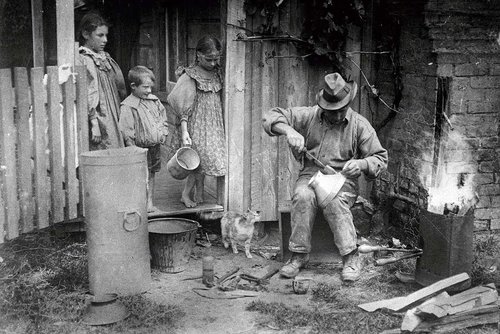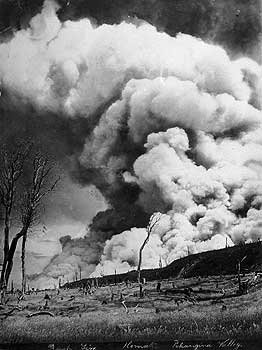
Environmental historian Dr Catherine Knight's new book explores the fascinating life and photographic legacy of Charles E Wildbore.
Environmental historian Dr Catherine Knight’s new book celebrates the life and work of a 19th century farmer and beekeeper whose photographs captured colonial life in a remote Manawatū valley and the dramatic changes to its landscape.
Charles E Wildbore was a passionate photographer whose black and white images of the Pohangina valley, river and village provide the visual story for the recently launched Wildbore: A photographic legacy (Totara Press).
Dr Knight says locals may be familiar with some of the images, which have been displayed in public spaces. Her research for the book unearthed the story of an unusual man she describes as likeable, eccentric and fastidious about his photography. His images help us understand how the environment was shaped by early settlers to look as it does today and how we might envisage its future restoration, she says.
Dr Knight, an honorary research fellow in the School of People, Environment and Planning at Massey University’s Manawatū campus and Pohangina resident says researching her previous book Ravaged Beauty: An environmental history of the Manawatu (Dunmore Publishing, 2014) first brought her into contact with the photography and stories of Mr Wildbore.
“I already knew how significant his photographs were in terms of capturing the dramatic transformation of a densely forested valley into orderly settlements and productive farms in a span of two short decades,” she said at the recent launch of the book. “His images are unique in so comprehensively capturing each stage of this transformation: the bush-whacking, the timber-milling, the bush-burning, the grass seed sowing and harvesting, and finally, the incinerated tree-pocked farms that emerged from this process.
“As it turns out though, the Wildbore family’s story – of how they came to be here and of the man himself was a fascinating one.”
Her mentor and colleague at Massey, Professor Mike Roche, a geographer who specialises in the history of forestry in New Zealand, suggested she write a book about Wildbore. Although she had a few doubts about the project at first, she discovered Wildbore, who came from England in 1874 with his parents, was “probably the sort of fellow it was impossible to dislike.”

'Travelling tinker' shows Charles Wildbore with three of his children, Kathleen, Mana and Sylvia (C.E.Wildbore/Palmerston North Library)
Family and farm life in pictures
And while his propensity to be fixated on interests other than earning a living – such as photography – may have been hard on his large family, she says he was a man who made the most of life’s opportunities.
“My impression is that he was a man whose attention to detail was second to none when it came to his photography – and I suspect his beekeeping – but less fastidious perhaps when it came to making a living. In fact, it appears that whenever Charles came into any spare money from the sale of his honey or a payment for a contract job, his first impulse was to spend it on a new camera.”
She says he was naturally inquisitive and “very interested in the processes he observed around him and felt the need to document them with his photography.”
From farming life to family scenes, weddings and community events, people were nearly always front and centre of his photographs. “He had a tremendous eye for composition, and mastery of the complex technical process involved in taking and developing photographs at that time,” says Dr Knight. “We are tremendously indebted to him for these photographs as a record of scenes and landscapes we would otherwise struggle to visualise.”


A bush burn, circa 1904, on a Pohangina valley farm is the photo Charles Wildbore is best known for (C.E.Wildbore/Palmerston North Library); and book cover.
Towering totara a vision for the future?
Wildbore's mages also offer hope for the future – “that those towering totara that appeared only as burnt skeletons in those rather desolate early shots of valley farms might one day be part of the landscape again, along with the kahikatea of the river flats and – the northern rata of the foothills and ranges.
“A future in which our forests and wetlands, and the birds and animals that inhabit them, can coalesce with the landscapes of human endeavour created by the pioneering settlers whose lives and landscapes Wildbore so expertly captured.”
He also had a strong social and humanitarian awareness. He joined the Manchester Friendly Society in his early 20s, a society offering financial help to those in need before state social welfare was established in New Zealand. The Wildbores took on the care of grandchildren whose parents found themselves in difficulty in the depression of the 1920s and their door was always open to the children of the Pohangina community, who, she says, “were no doubt attracted by the baked goods on offer as much as Charles’ yarns – including the one perhaps about attending to Charles Dicken’s horse outside the pub!”
Dr Knight’s foray into environmental history began 10 years ago when she consulted Professor Roche for an article she wrote for the Manawatu Journal of History about the Totara Reserve in the Pohangina Valley. She says a “light went on” doing research in this field, an interesting segway from her undergraduate Chinese and Japanese undergraduate studies at a Japanese university, and Master of Arts from Canterbury University on Japanese perceptions of the environment, and the paradoxical veneration and destruction of nature. She has graduate diplomas in Chinese Language and Business Studies, and a post-graduate diploma in Development Studies from Massey University.
Wildbore: A Photographic Legacy is available from Nationwide Book Distributors and bookstores.